Are Pavers a Good Option Around Inground Pools? A Professional Guide
Updated: September 2nd, 2025 | Published: May 11th, 2016
4 min read
By Jason Hughes
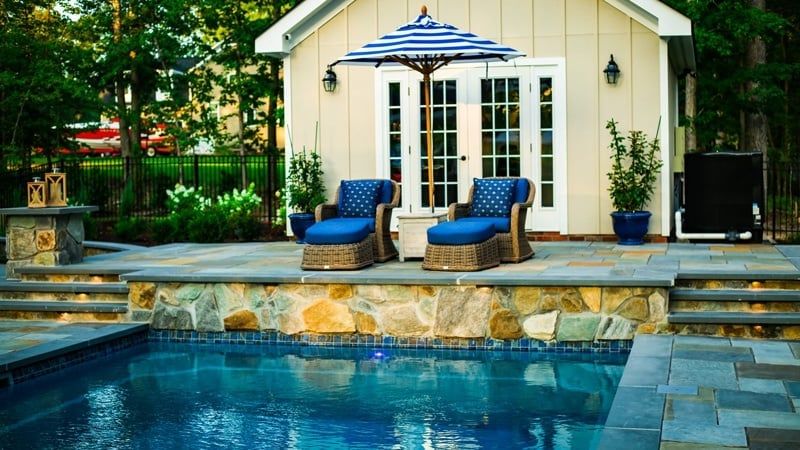
When you're planning an inground pool project, one of the most important design decisions you'll make is what to put around the pool. Your patio surface affects not just the look of your backyard—but also safety, maintenance, comfort, and long-term value.
Among the many options, interlocking concrete pavers continue to be a favorite for homeowners seeking a combination of beauty and practicality.
This guide explores why pavers work well around fiberglass pools, how they’re installed, and how they compare to other common pool decking materials. It also includes real-world installation advice for performance in climates like Virginia, where freeze-thaw conditions are a major consideration.
Why Homeowners Choose Pavers Around Pools
Patio pavers are individual units—usually made of concrete or natural stone—that interlock to form a flat, walkable surface. Unlike poured concrete, which can crack and be difficult to repair, pavers offer flexibility, style, and durability that make them particularly attractive for pool environments.
Benefits of Patio Pavers for Pool Decks
-
Design variety: Choose from multiple shapes, sizes, colors, and layout patterns.
-
Slip resistance: Many pavers feature textured surfaces that offer great traction when wet.
-
Cooler temperatures: Light-colored pavers stay cooler in direct sun compared to concrete or bluestone.
-
Low-maintenance repairs: If one paver gets damaged, it can be replaced without redoing the whole patio.
-
Natural drainage: Pavers allow water to drain between joints, reducing puddles and runoff issues.
Related: How Hot Do Swimming Pool Patios Get? (Concrete, Pavers, Travertine, Bluestone)
Potential Drawbacks to Consider
-
Upfront cost: Pavers typically cost more than standard brushed concrete.
-
Installation time: Laying pavers by hand is labor-intensive.
-
Stability depends on base: Improper base prep can lead to uneven or shifting pavers over time.
-
Joint maintenance: Weeds or ants may appear if polymeric sand isn’t used in the joints.
How Pavers Are Installed Around a Fiberglass Pool
Whether you're working with a fiberglass, vinyl liner, or concrete pool, the paver installation process is largely the same after the pool and coping are in place.
Here’s a proven method used on pool projects across Virginia:
1. Prepare the Base
Install a 4–6" thick compacted layer of “crusher run” gravel. In freeze-prone areas, 6–8" is preferred for long-term durability.
2. Add Leveling Sand
A ½-inch layer of sand is spread and screeded to create a smooth, even surface for laying the pavers.
3. Lay the Pavers
Pavers are placed in the chosen pattern, using string lines to maintain alignment and consistency.
4. Lock It In
A vibratory plate compactor is used to set the pavers, followed by sweeping polymeric sand into the joints for added stability and weed resistance.
What Kind of Pool Coping Works Best with Pavers?
Coping
is the material that borders the pool and creates a transition between the pool and patio. These coping styles integrate especially well with paver decks:
-
Cantilevered concrete: Poured-in-place concrete that slightly overhangs the pool edge.
-
Bullnose paver coping: Matches the patio for a cohesive, continuous surface.
-
Natural stone coping: Offers durability with a high-end aesthetic.
Compare Coping Styles: Stamped Concrete vs. Pavers
How Do Pavers Compare to Other Pool Patio Materials?
Not sure if pavers are right for your backyard? Use the comparisons below to weigh your options.
1. Pavers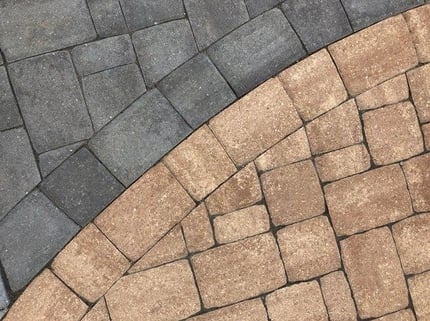
-
Cost: $$$
-
Durability: High (with proper base prep)
-
Repairability: Easy—individual pavers can be replaced
-
Heat Retention: Cooler underfoot in light colors
-
Appearance: Highly customizable with many layout possibilities
2. Brushed Concrete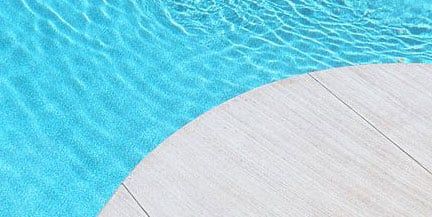
-
Cost: $
-
Durability: Medium—can crack over time
-
Repairability: Difficult—cracks are permanent
-
Heat Retention: Medium-hot in full sun
-
Appearance: Clean and simple, but less decorative
3. Stamped Concrete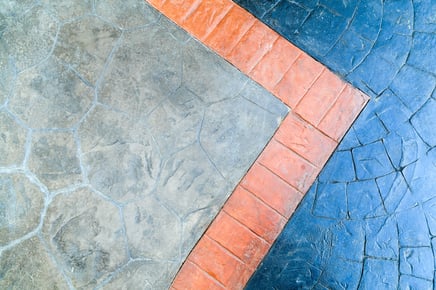
-
Cost: $$
-
Durability: Medium—also prone to cracking
-
Repairability: Difficult—cracks can disrupt the pattern
-
Heat Retention: Hotter than brushed concrete
-
Appearance: Decorative textures that mimic stone or brick
4. Travertine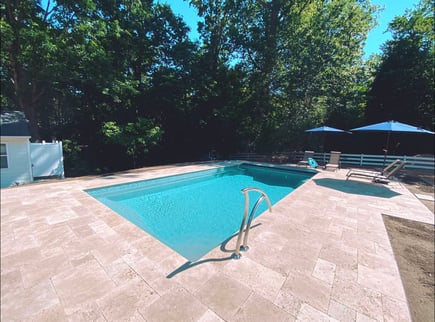
-
Cost: $$$$
-
Durability: High
-
Repairability: Easy—individual tiles can be replaced
-
Heat Retention: Very cool underfoot
-
Appearance: Elegant, upscale natural stone
5. Bluestone
-
Cost: $$$$
-
Durability: High
-
Repairability: Easy—stones can be swapped as needed
-
Heat Retention: Can get very hot
-
Appearance: Classic, natural tones popular in luxury builds
Real-World Tips for Paver Pool Patios in Virginia & Beyond
These insights are based on field experience with pool and patio installations in Virginia’s varied climate and soil types:
-
Deeper gravel base is essential. Freeze-thaw cycles demand a base of 6–8 inches.
-
Light-colored pavers perform better in sun. They retain less heat and stay more comfortable.
-
Use polymeric sand. It reduces maintenance, prevents washout, and blocks weeds and ants.
-
Add design features. Contrasting borders, curves, or multi-tone patterns boost visual appeal.
Is a Paver Patio Right for Your Pool Project?
Pavers are ideal if you're looking for:
-
Long-term durability with low maintenance
-
Flexible and elegant design options
-
Easy repairs without replacing the entire patio
-
Cooler surfaces around the pool
-
A high-end look that adds value to your property
They cost more upfront than basic concrete but offer a strong return on investment in both performance and appearance.
View more: Fiberglass Pool Patio and Coping Options
From the Author: Jason Hughes
Over the past 20+ years, I’ve probably installed more than 1,000 fiberglass pools across Virginia—and one of the most common questions I get from homeowners is:
“Are pavers a good option for my pool patio?”
I wrote this article to answer that question once and for all—with real-world insights from the job site. Not from a showroom, not from a catalog, but from years of hands-on experience installing pool patios in all kinds of soil, slope, and weather conditions.
My goal is to help you make a confident, informed decision about what goes around your pool—not just what goes in it. Pavers can be a great option, but like any material, they’re not one-size-fits-all. I hope this guide helps you think through the details so your finished backyard looks great and works great for years to come.
From the Manufacturer: River Pools
River Pools manufactures fiberglass pool shells and provides extensive educational resources to help homeowners make confident decisions. Our goal is to guide customers through every stage of pool planning—from design to decking—by sharing accurate, experience-based content from professionals like Jason. Learn more at our Learning Center.
Jason Hughes is a partner at River Pools Virginia, a fiberglass pool installation company based in Warsaw, Virginia. With over 20 years of hands-on experience, Jason has dedicated his career to helping families create beautiful, functional backyards while ensuring every fiberglass pool installation meets the highest standards of quality and safety. In addition to his work with homeowners, Jason serves as a GENESIS instructor with the Pool & Hot Tub Alliance (PHTA), where he teaches fiberglass pool installation best practices to pool professionals across the country. Whether he’s on a job site or leading a training session, Jason is passionate about raising the bar for fiberglass pool installations and helping families make confident, informed decisions as they transform their outdoor spaces.
Topics:



